Lindsay Olson: Art, physics and the elegant Universe
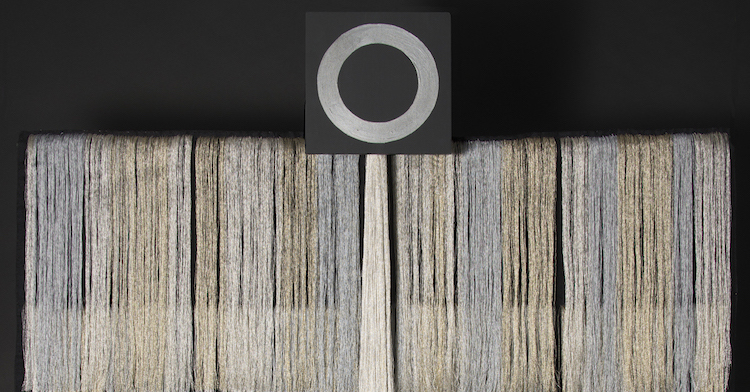
Lindsay Olson is Fermi National Accelerator’s first Artist in Residence and is on the faculty at Columbia College Chicago. She is known for creating unusual residencies including a stint as the resident artist at Chicago’s Metropolitan Water Reclamation District.
Her work has been featured in Scientific American, the Chicago Tribune, SciArt in America and the Chicago Artist Resource. She has shown her work in many galleries both in the US and internationally including Vienna, London, Geneva and Athens. Her work is now touring both the US and in Europe.
In this interview, Lindsay tells us how an irresistible offer from the Fermilab art committee has challenged the way she approaches art and the wider world.
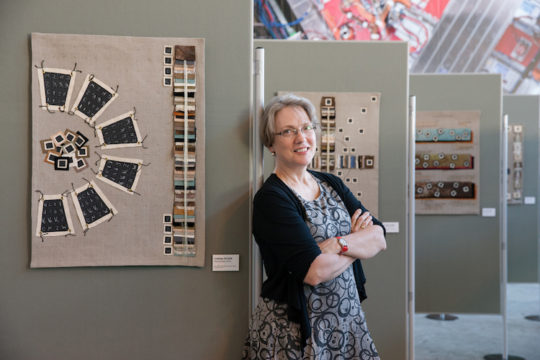
Lindsay Olson taken at P5 at CERN. Photo, Bree Corn.
An irresistible offer
TextileArtist.org: Will you give us an overview of your work?
Lindsay Olson: My work space has some unusual supplies for an artist’s studio. Pinned to my idea board, I have a list of sub atomic particles, quotes from popular physics books and a picture of Nobel Lauriat Marie Curie. I use my art to explore and explain how particle physics underpins all of life. As Fermilab’s first artist in residence, I found making art about physics was an act of discovery. Using science and art together not only energized my studio practice, it has changed the way I see our universe.
Were you always interested in science? How did you end up being chosen as Fermilab’s first artist in residence?
For most of my academic career, I did my very best to avoid math and science. I also used to have a more traditional studio practice painting water ways and landscapes but I stumbled, quite accidentally, over the scientific underpinnings of water management in a dense urban area and my studio practice has never been the same.
In the spring of 2014, Georgia Schwender and members of the Fermilab art committee came see one of my shows. Georgia had wanted to establish an artist residency at Fermilab for a long time and when she learned about my work, she invited me to develop a pilot residency designed to be one part of a robust outreach program at the lab.
My first thought on hearing her proposal was to cheer! Someone was inviting me to establish a residency. In previous projects, I had to do jump though some fearsome hoops to gain permission to make my work.
My second thought made me pause. I wondered if particle physics was too complex a subject for me to learn. But ultimately, I accepted the challenge because the offer was irresistible.
How do you begin your projects and what process do you use to integrate science and art?
This residency has taken two years to complete. I’ve spent hundreds of hours interviewing scientists and other staff at the lab, touring the experiments, taking training and reading. I design my projects as a full immersion experience and out of this scaffolding, I create accessible art that helps explain what scientists learn about how particles behave. After learning about the science, I began filling up sketchbooks and creating small textile samples to work out how to blend the science and the elements and principles of design.
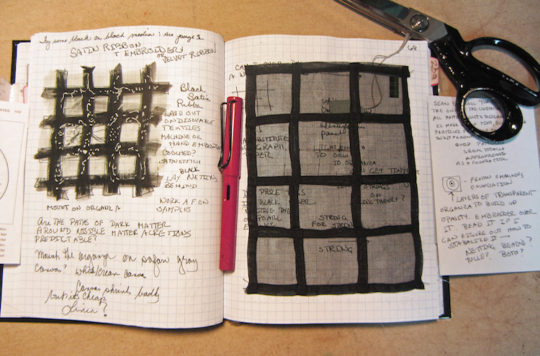
Early sketch book idea for Neutrinos I
Were scientists willing to help you learn such a complex area of science?
On my first day at the lab, someone handed me a book by senior scientist Don Lincoln called The Large Hadron Collider and I studied Don’s book while on vacation. In particular I read (and re read) the first chapter in which Don explains in layman’s terms, what the standard model is and why it is important. There’s lots of other great stuff in this book, but the standard model chapter specifically sparked my imagination. This book was not only a door into understanding a completely different way to grasp realty, but Don’s approach to explaining particle physics was perfectly pitched to me, a non-scientist.
In fact, many people at Fermilab generously spent lots of time explaining various aspects of physics to me. I’ve been privileged to have some of the world’s greatest physics minds teach me about their work.
This is not to say I did not struggle with the material.
In fact, I arm wrestled with all these ideas for quite some time. One of the biggest obstacles to learning about High Energy Physics was accepting that how particles behave in the quantum realm is counter intuitive to the way in which we perceive reality. To continue to absorb this information, I had to make space for both versions of reality…the reality I experienced through my senses on a daily basis and the reality physicists have discovered on the quantum scale. One example among many of this dual view of reality is that things that appear solid to us are in fact made up of a field of wiggling, jiggling particles.
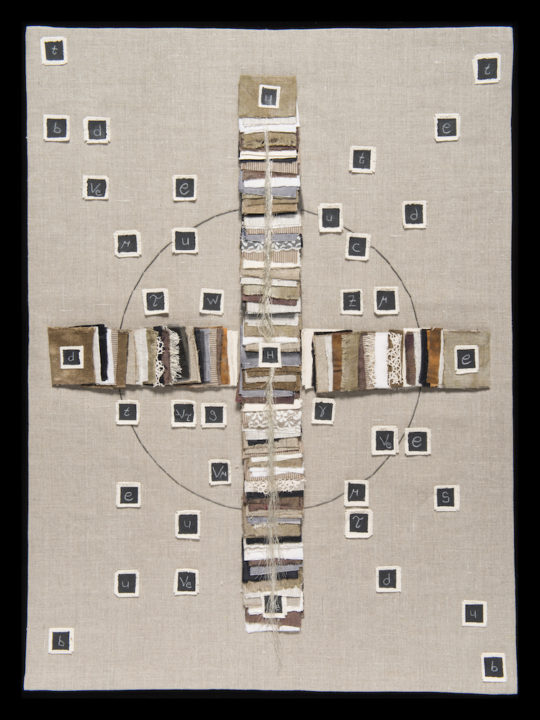
Lindsay Olson, X and Y Axis, 2015
Why did you begin your work with the Standard Model of particle physics and what is it?
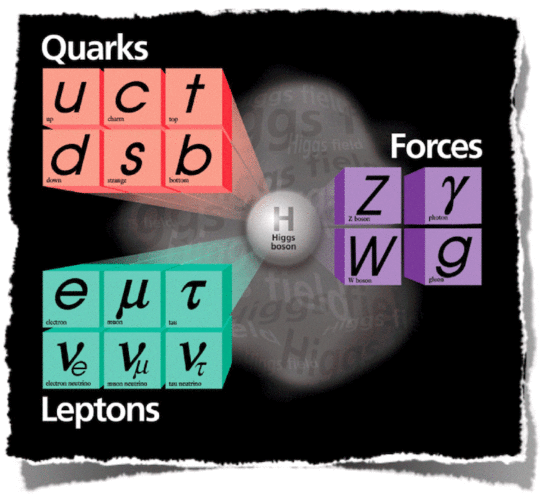
The Standard Model of particle physics
The Standard Model was the first piece of physics I learned. Most of us have heard about the periodic table of elements. The Standard Model is a way to organise particles that make up atoms and the forces that govern their behaviour.
What attracted me to the SM was that imbedded in its mathematics, there are deep implications….but on the surface, it looks simple! The Standard Model can be used to explain the basics of particle physics to junior high students and yet holds deep mysteries for scientists working at the top of their field.
Why do you use textiles in your work? What initially attracted you to textiles as a medium?
Most of the women in my family were accomplished seamstresses and knitters. My grandmothers and mother taught me to sew, knit and embroider. I studied fashion design as a young person and worked in the field for a number of years. Later, I returned to school as a mature student to earn a degree in fine art. It’s a great source of satisfaction to integrate all the creative areas of my life into my current work.
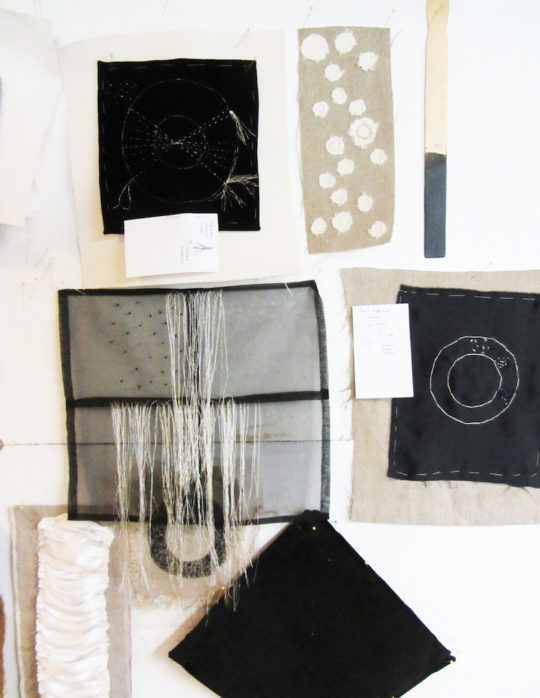
Idea board for neutrino pieces
Textiles are something everyone uses in their daily life. Some artists use oil paint, water colour and other traditional materials. The materials I use for each project are as much a part of the work as the subject matter. Because some people find science intimidating, I want to have the least amount of artistic distance between the viewer and the art. Everyone uses textiles in their daily lives so creating work in them felt like a natural choice.
How do you use the elements and principles of design to reinforce the science in your art?
The study of Physics is ancient and I wanted to use color to express its early origins. I’ve included a raw linen base, dyed textiles that suggest the colors of antiquity. The work is created with silks, cottons, lace and blackboard paint for obvious reasons. There are blackboards everywhere at Fermilab.
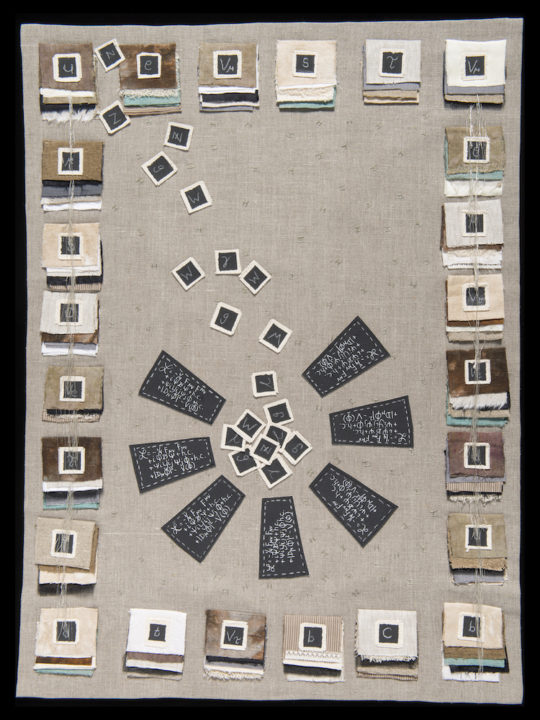
Lindsay Olson, Particle Soup, 2014
The format and size are important to me. The pieces are human size. Physics deals with scales that are both infinitesimal and cosmic but I wanted to use the size of the art to invite the viewer into the subject matter: to make it more approachable. It’s the difference between a huge public mural created during the Renaissance in the city states of Italy or the more personal scale of books created in Northern Europe.
I chose a grid format not only to visually anchor the work but to hint at the graphs used in analyzing data. I included the history of particle discoveries, the measurements necessary for observations by referencing books…graphs and blackboards. The books are loosely sewn together with silver thread but do not look like completely finished books… this suggests the unfinished business of scientific inquiry.
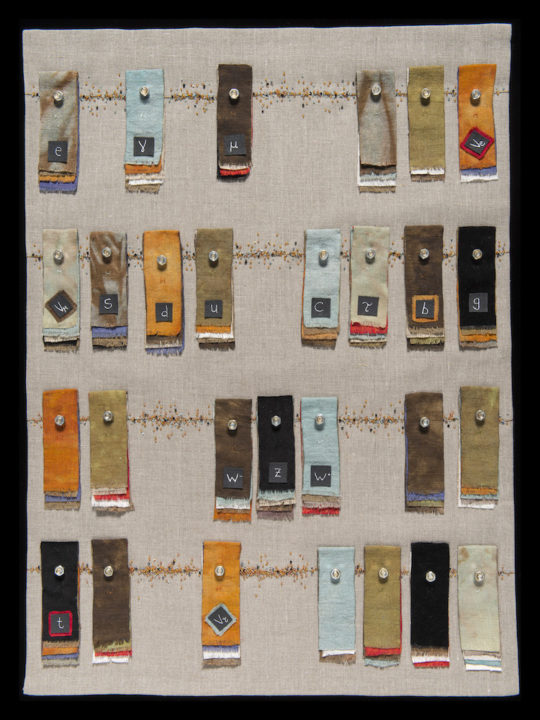
Lindsay Olson, Nuts and Bolts, 2014
I also use a lot of time consuming hand processes in making the pieces: beading, embroidery and hand sewing. In the piece “Nuts and Bolts” is a beaded time line suggesting a sort of royal road to the discovery of particles. Historically, beading and hand embroidery were used on the clothing of royalty and the wealthy. Using these sorts of processes to create the art elevates the subject matter.
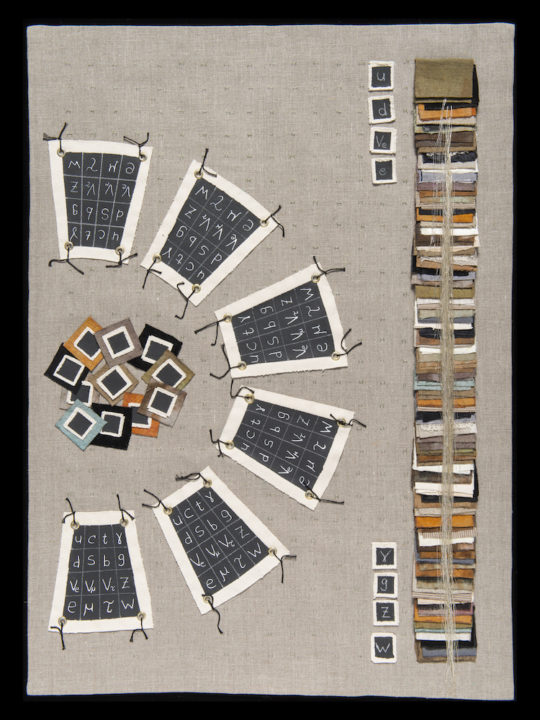
Lindsay Olson, Discoveries, 2014
Science is driven by new discoveries. Are you worried any of your work will become obsolete?
The Standard Model of particle physics has been hugely successful in predicting particles, including the Higgs Boson whose existence was experimentally confirmed in 2012. However, after years of correctly predicting particles, physicists know the standard model does not tell the complete story.
In “Discoveries”, a short version of the SM equation looks provisionally attached to the piece. I am expressing the idea that the standard model may have to be substantially changed due to new discoveries. Because I don’t want my art to become obsolete, I’ve left room for undiscovered particles.
Your work is on tour in Europe. How did that come about?
I was fortunate to meet the founder of a project at CERN called Art@CMS, Michael Hoch and he invited me to participate in his international exhibition. Part of the invitation included a trip to CERN in Geneva, Switzerland. CERN is Europes high energy physics laboratory and well known for the discovery of the famous Higgs Boson in 2012. Visiting CERN was every bit as wonderful to me as visiting Paris is to someone else. Tootling around campus on my rented bicycle, I attended tours, lectures and got to see the huge experiments up close.
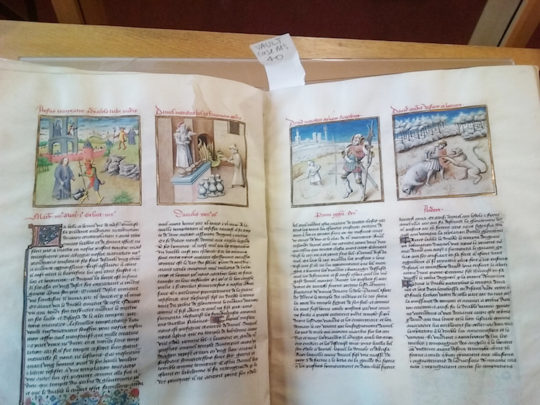
Medieval Illuminated Manuscripts
What ideas did you bring back with you from the trip to CERN?
While I was in Geneva, I had a chance to visit the Martin Bodmer Library where I saw an excellent show on Medieval Illuminated manuscripts.
The study of these beautiful books inspired me to combine high energy physics and the format of an illuminated manuscripts into my own artist books. Medieval manuscripts were used to transmit the most important information of their day. My books illustrate the deep and fundamental connection between particle physics research and the origins of the universe.
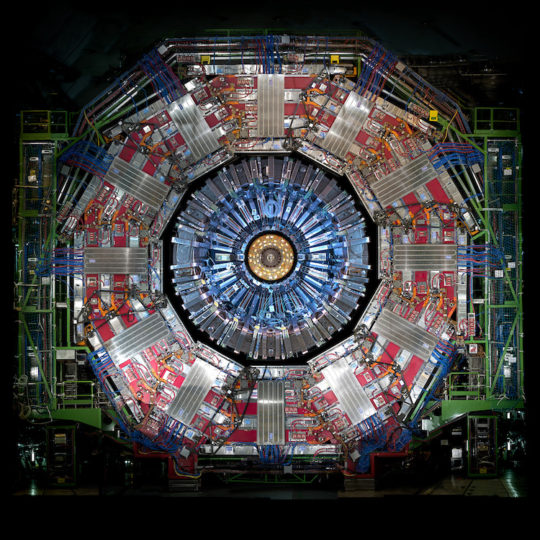
The CMS experiment at CERN by Michael Hoch
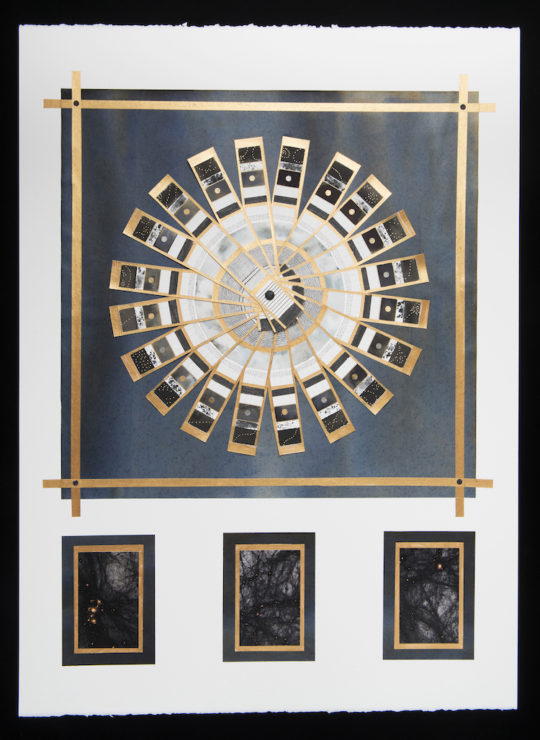
Lindsay Olson, Illuminated Book CMS III, 2015
In experiments at CERN particle physicists recreate the conditions that existed in the early universe. By smashing protons together at high energies, the resulting reactions illuminate conditions in the early universe.
The book format suggests the circular shape of detectors like CMS and Atlas located around the 27-kilometre accelerator ring.
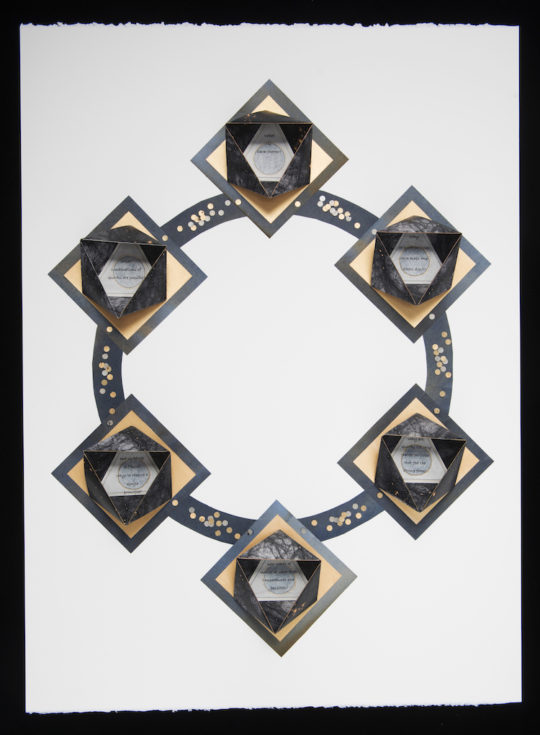
Lindsay Olson, Illuminated Book Box I, 2015
Tucked inside each origami shaped box are questions physicists would very much like to answer.
- Why do the forces have such disparate strengths and ranges?
- Why is there more matter than anti-matter in the universe?
- Is there something smaller inside quarks and leptons?
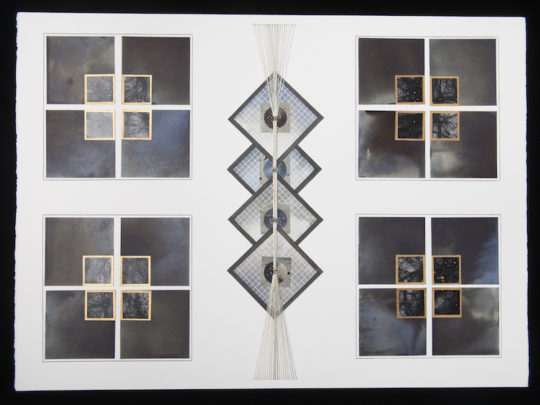
Lindsay Olson, Illuminated Book Beam, 2015
Does Fermilab have a particular research focus that you wanted to express in your project?
At Fermilab, scientists study many aspects of particle physics but of particular focus are tiny, ubiquitous particles that are deeply mysterious: neutrinos.
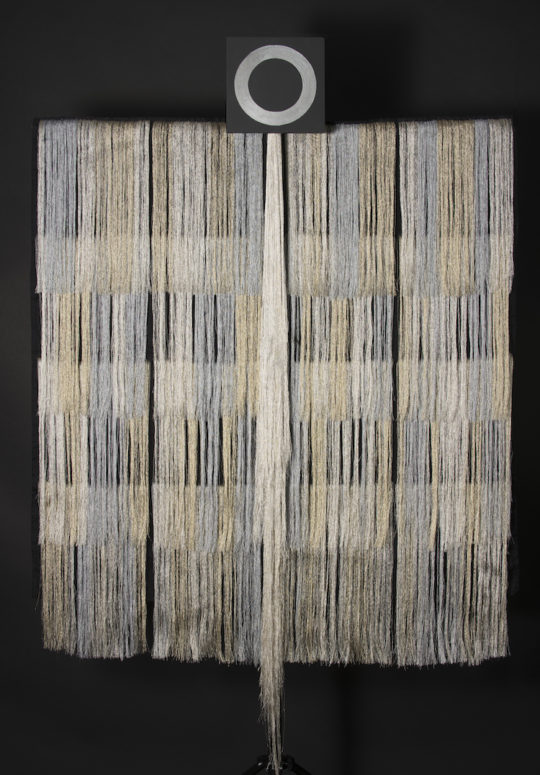
Lindsay Olson, Dark Glamour Neutrions, 2015
Our universe is permeated with neutrinos — nearly massless, neutral particles that interact so rarely with other matter that trillions of them pass through our bodies each second. Studying these particles will lead to a deeper understanding of our universe.
In this piece, I’ve constructed a curtain that suggests a sort of theatrical space: a sort of stage for the presentation of a set of these mysterious particles. Subtle shades of silver, steel and gold represent the three flavours of neutrino particles…. We don’t understand yet why these particles osculate between these three flavours.
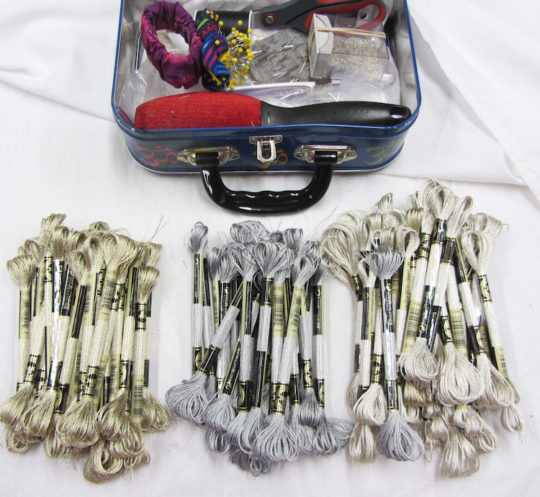
Organising 3 miles of DMC embroidery floss for two nutrino pieces
Organizing 3 miles of DMC metallic embroidery floss.
Neutrinos emanate from the earth, from the sun, they arrive from the distant cosmos. And neutrinos are manufactured at Fermilab with sophisticated technology that begins with a bottle of hydrogen. In this piece, I’m portraying the billions of particles of neutrinos in the beam created at Fermilab as an elegant cascade of metallic fibres. One of the scientists calculated, (in his head) that I used 3 miles of metallic embroidery floss for this piece and the next one.
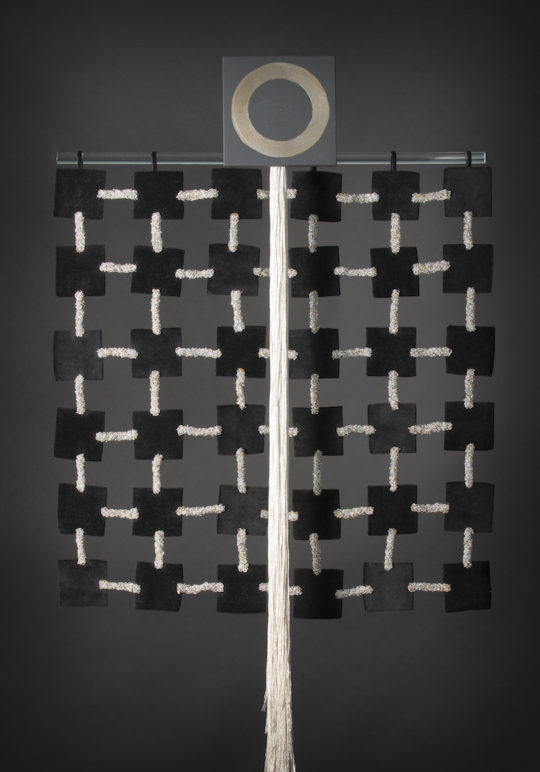
Lindsay Olson, Dark Glamour Neutrinos II, 2015
In both of the pieces, I am using the visual metaphor of nets to suggest how detectors capture images of these rarely interacting, elusive particles. The art borrows techniques used in high fashion to project an image of dark glamour.
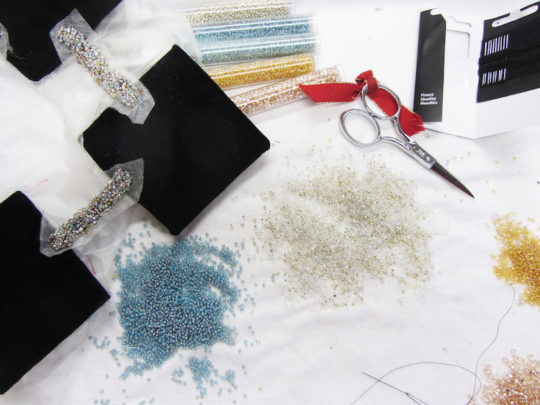
Three colours of seed beads for Neutrions I
The detector is represented by velvet squares joined by lines of beads in three subtle colours. Again, I’m using three colours of seed beads to express the dynamic nature of neutrinos. What was one of the most memorable parts of the residency?
One of the most interesting parts of my residency involved shadowing operators who maintain the beautiful machinery that delivers a beam of particles for scientists to study. In order to travel to the guts of the experiments, I undertook rigorous training to prepare for my visits. Seeing this equipment and learning about the expertise to keep it functioning was thrilling. Very few outsiders have this privileged view of the experiments.
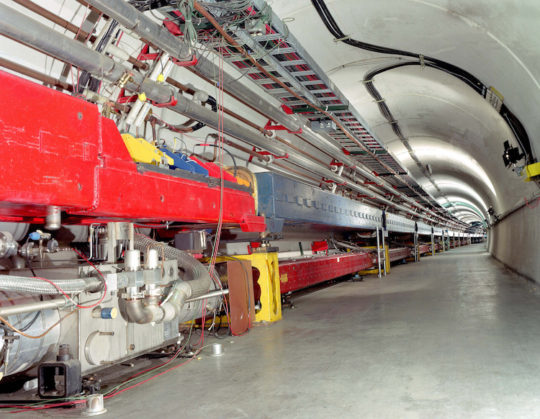
Magnets in Fermilab’s underground tunnel by Reidar Hahn
Why is accelerator science important to particle physics research?
Accelerator science is all about riding a bucking bronco of particles. Understanding how this energetic beam behaves showed me that nature is not just about birds and fluffy animals. Fundamental particles are part of nature too. Because the particles in this beam all have the same charge, they want to spread out. More than 1000 super-conducting magnets strategically placed around the Main Injector steer and compress the particles while they travel near the speed of light. Then they are shot into a target. Sometimes, but rarely, neutrinos collide with other particles and scientists can use that information to study their behaviour. Without this complex machinery, Neutrinos interact so rarely that it would be almost impossible to study them in one person’s life time.
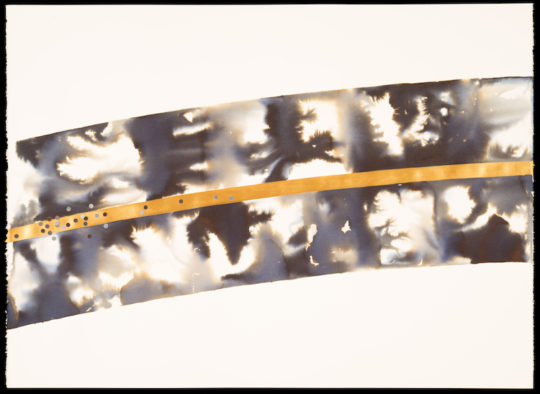
Lindsay Olson, Detail of Accelerator Drawing, 2015 , 90″ long
These drawings celebrate the nature of the particles and the powerful magnetic forces that control them. I’m using a technique of wet on wet ink here to express the wild nature of the particles and the magnetic forces controlling them. The particles travel in packets or pulses around the ring. The accelerator division is responsible for ensuring that the best beam possible is delivered to the experiments.
What message do you hope viewers will take with them after seeing your work?
One of the most powerful lessons I learned with this residency is that I am not afraid to learn any kind of science…even High Energy Physics. This residency offered me an opportunity to create a space where art and science can work together to communicate to the mysteries of the universe. I hope my artwork inspires others to explore their own questions and discover for themselves that you don’t need to have a Ph.D. to fall in love with science.
My work will be shown and I will be speaking in August at the International High Energy Physics Conference in Chicago. You can also see the work at Fermi National Accelerator Laboratory’s art gallery in October, November and December of 2016 as well as many other venues here and abroad. If you are interested in having me speak, please contact me through my website or Fermilab.
Particle Fever is an Oscar-winning and highly entertaining film about the science conducted at CERN.
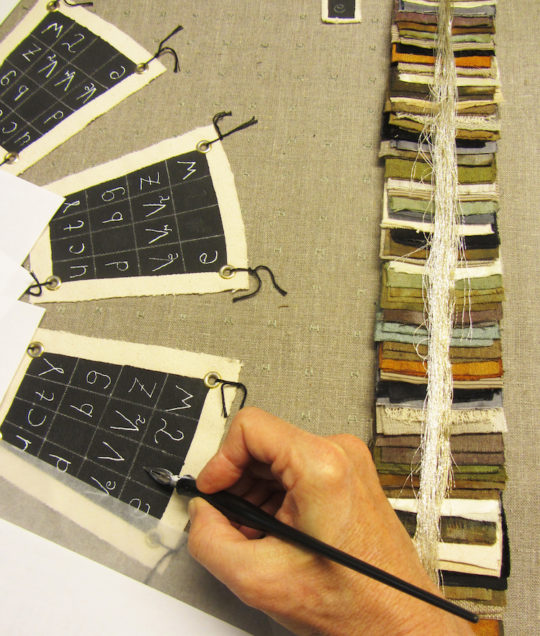
Correcting math symbols on the Standard Model piece
Artistic influences
William Kentridge: An artist working with issues surrounding post-apartheid South Africa.
Cristo: I love his bold vision and his tenacity working with urban bureaucracy. When I felt discouraged about the long approval process in a project, I was inspired by his patience.
Louise Bourgeois: Her work is exciting and bold: especially her textile work.
Zarina: She works elegantly with an economy of means.
Olga de Amaral: Her combination of textiles and gold leaf is stunning
For more information visit: www.lindsayolsonart.com
Let us know what your favourite aspect of the artist’s work is by leaving a comment below.
















What a fascinating article The integration of science and art Inspirational pieces
I love Lindsay’s creative interpretations of physics, and this article was a great insight into her thinking and techniques. As she says “you don’t need to have a Ph.D. to fall in love with science”.
WOW